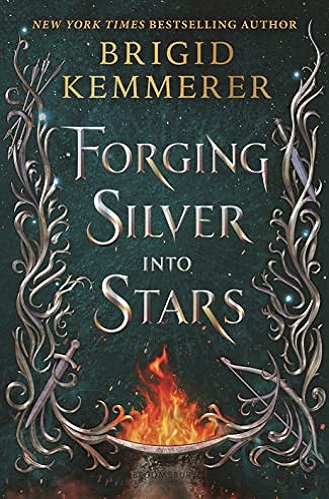Magic has been banished in the land of Syhl Shallow for as long as best friends Jax and Callyn can remember. They once loved the stories of the powerful magesmiths and mythical scravers who could conjure fire or control ice, but now they’ve learned that magic only leads to danger: Magic is what killed Callyn’s parents, leaving her alone to raise her younger sister. Magic never helped Jax, whose leg was crushed in an accident that his father has been punishing him for ever since. Magic won’t save either of them when the tax collector comes calling, threatening to take their homes if they can’t pay what they owe.
Meanwhile, Jax and Callyn are astonished to learn magic has already returned to Syhl Shallow — in the form of a magesmith who’s now married to their queen. Now, the people of Syhl Shallow are expected to allow dangerous magic in their midst, and no one is happy about it.
When a stranger rides into town offering Jax and Callyn silver in exchange for holding secret messages for an anti-magic faction, the choice is obvious — even if it means they may be aiding in a plot to destroy their new king. It’s a risk they’re both willing to take. That is, until another visitor arrives: handsome Lord Tycho, the King’s Courier, the man who’s been tasked with discovering who’s conspiring against the throne.
Suddenly, Jax and Callyn find themselves embroiled in a world of shifting alliances, dangerous flirtations, and ancient magic… where even the deepest loyalties will be tested.
The first book in a spinoff from the Cursebreakers series, Forging Silver into Stars is a deliciously written fantasy written from three alternating first-person narrative points of view. The world-building is precise and fully realized, and the main characters — Jax, Callyn and Lord Tycho—are unique, believable and sympathetic. The plot, though lacking much action for most of the story, does build to a thrilling climax.
The clear, resonant descriptions set the scene early on: “The moon hangs high over the trees, making the frozen branches glisten, turning the ground between the house and the barn into a wide swath of crystalline white. A few inches of snow fell at dusk last night, keeping away any customers Nora and I might have had for the bakery.”
This imagery isn’t limited to the environment; the characters, too, are well drawn: “I watch his hands move with practiced efficiency. His fingers are red from the cold, scarred here and there from forge burns.” The language and descriptions quickly drew me into the story.
In terms of genre, this book is a little hard to pin down. While there is discussion of magic — especially that of King Grey, the magesmith responsible for the deaths of many, including Callyn’s mother — there is very little actual use of magic in the story, as compared to a novel like, say, Children of Blood and Bone, where magic is a prominent feature. Magic is used only a few times throughout the novel, mostly to heal Tycho or Jax, and only once is it used in a fight. There is also only one fantastic creature in the novel, a winged, claw-endowed scraver named Nakiis, whom Tycho frees from bondage.
However, because the magic and the scraver appear so little in the novel, it really reads like a historical novel set in Europe’s Middle Ages. Everything in the culture of the people of Emberfall and Syl Shallow works and operates as you would expect from a novel set in that period and place — from the sometimes archaic or formal constructions of language to expectations of family and community.
There is one place where the novel deviates from those cultural norms; while all other aspects of the society are to be understood in terms of Europe’s Middle Ages, homosexuality is normalized in the novel in a way that seems incongruous with the rest of the society and its rigid social order. Jax and Tycho, as Jake puts it, have “no hang-ups” about their relationship being public, despite the very dire consequences for such relationships in the historical parallel. In effect, the world of the novel was not different enough from historical Europe for this difference to seem believable.
That said, the romance between Jax and Tycho is believable in and of itself, but until they meet, there is no indication that either of them is gay. In terms of identity, both characters read as straight — even to other characters like Nora, who suggests Callyn and he might get together — up until the moment Jax and Tycho are described as having feelings for each other. Similarly, the relationship between Lord Alek and Callyn seems out of place. There is no explanation for why the powerful, arrogant and aristocratic Lord Alek is interested in the poor bakery girl; while romances crossing the social strata are a trope in fairy tales, even Cinderella must first be disguised as a noble to get the attention of Prince Charming. Their relationship provides the romance necessary for a young adult story, but doesn’t seem to fit with Lord Alek’s otherwise haughty character.
Verdict: While this novel may falter in the action of its plotting and the believability of its romances, the intrigue, language and character development make this a valuable addition to any library.
– Mark David Smith


